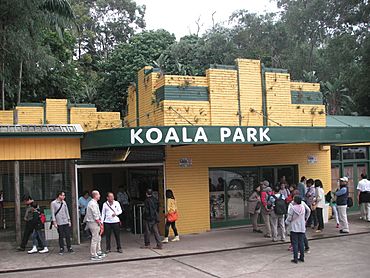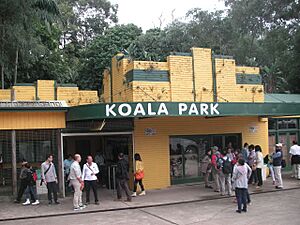West Pennant Hills, New South Wales facts for kids
Quick facts for kids West Pennant HillsSydney, New South Wales |
|||||||||||||||
|---|---|---|---|---|---|---|---|---|---|---|---|---|---|---|---|

Koala Park
|
|||||||||||||||
| Population | 16,620 (2021 census) | ||||||||||||||
| Established | 1796 | ||||||||||||||
| Postcode(s) | 2125 | ||||||||||||||
| Elevation | 176 m (577 ft) | ||||||||||||||
| Location | 21 km (13 mi) NW of Sydney CBD | ||||||||||||||
| LGA(s) |
|
||||||||||||||
| State electorate(s) | Castle Hill | ||||||||||||||
| Federal Division(s) | |||||||||||||||
|
|||||||||||||||
West Pennant Hills is a suburb in the Hills District of Sydney, New South Wales, Australia. It is located about 21 kilometers northwest of the Sydney city center. West Pennant Hills is managed by two local councils: The Hills Shire and Hornsby Shire.
Contents
Shopping and Local Services
West Pennant Hills is mainly a place where people live. It has a shopping area called Thompsons Corner. The suburb's public school, West Pennant Hills Public School, is also located here.
The Cherrybrook railway station is just north of West Pennant Hills. It is near Castle Hill Road. Close by, there is another shopping complex on Coonara Avenue. This complex has a Woolworths supermarket, restaurants, and other small shops.
History of West Pennant Hills
How Thompsons Corner Got Its Name
Thompsons Corner is named after Andrew Thompson (1773–1810). He was a convict who received a large piece of land in 1796. This land was opposite a signal station in Pennant Hills.
Around 1890, workers building the railway from Strathfield to Hornsby set up a camp here. During the time Lachlan Macquarie was governor (1810–1821), a timber-sawing business was near today's Thompsons Corner. In the early 1990s, one of the last sawmills was taken down. It had stood at the bottom of Hill Road.
The Meaning of "Pennant Hills"
The name "Pennant Hills" comes from both the natural hills and something man-made. When Sydney was first settled, "Pennant Hills" referred to the hills stretching north from Parramatta.
The "Pennant" part refers to a flag pole. This pole was put up on the highest point of the area. In the early days of Sydney, this flag pole with its pennant (a type of flag) was used for communication. It helped the government in Parramatta talk to the governor's home outside Sydney.
When the governor's horse-drawn carriage passed Thompsons Corner, the pennant would be raised. The soldiers in Parramatta could see this flag clearly. It told them to get ready for the governor's return in a few days.
The Story of the School and the Suburb's Name
In 1850, a school called Pennant Hills Public School was approved. It was one of the first schools in the Sydney area. The original Pennant Hills township was centered at the intersection of Pennant Hills and Castle Hill Roads. This was an important trading spot.
Later, a new school was built in 1925 closer to the railway station. This new school was called 'Pennant Hills East'. Because of this, the original school added 'West' to its name. It became 'Pennant Hills West'. Eventually, the area around Thompsons Corner became known as West Pennant Hills.
The Pennant Hills Post Office opened in 1867. It was renamed West Pennant Hills in 1898. This happened because the new Pennant Hills Railway Station office (which opened earlier) was given the name Pennant Hills. West Pennant Hills officially became its own separate suburb on August 23, 1986.
Fun Places and Nature
West Pennant Hills has some great places for fun and nature. You can visit the Cumberland State Forest. It's a beautiful forest to explore. There's also the Koala Park Sanctuary, where you can see koalas and other Australian animals.
People and Community
In 2021, West Pennant Hills had a population of 16,374 people. Here are some interesting facts about the community:
- The average age of people living here was 43 years old.
- About 18.3% of the people were children aged 0–14 years.
- About 20.0% of the people were 65 years and older.
- Most people (57.5%) were born in Australia. Other common birthplaces included China (8.6%), India (4.3%), and Hong Kong (3.5%).
- Most people (58.7%) spoke only English at home. Other languages spoken included Mandarin (11.1%) and Cantonese (7.4%).
- When it came to religion, 31.5% of people said they had no religion. Catholic (25.0%) and Anglican (12.4%) were also common.
- The average weekly household income for the suburb was $3,078. This means families in West Pennant Hills generally have a good income.
Famous People from West Pennant Hills
Many interesting people have lived in West Pennant Hills:
- Dame Alice Chisholm was a humanitarian. This means she worked to improve people's lives and reduce suffering.
- Damien Tudehope is a politician. A politician is someone who works in government and helps make decisions for the community.
- Dominic Perrottet was the Premier of New South Wales. The Premier is the leader of the state government.
- Captain Francis de Groot lived at Dunrath, 139 Castle Hill Road. He was known for an event at the opening of the Sydney Harbour Bridge.
- Len Beadell was an explorer. Explorers travel to new places to discover them.
- Guntis Sics was nominated for a Best Sound Oscar for the movie Moulin Rouge! in 2002. This means his work on the movie's sound was considered excellent.


